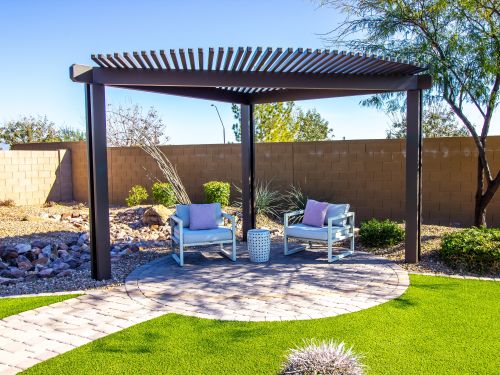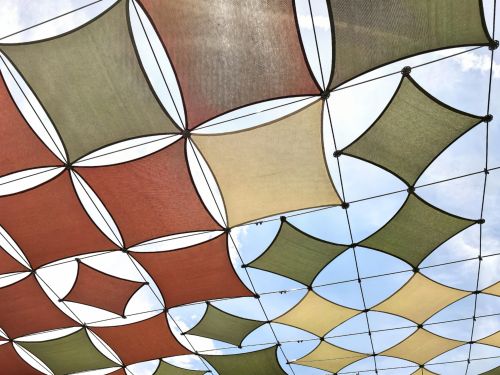Living in a desert climate means embracing the sunshine—but also finding creative ways to escape it. Creating shade in your desert yard not only makes outdoor spaces more comfortable but also helps protect plants, reduce energy costs, and extend the life of patio furniture. The key lies in using desert-friendly shade structures like pergolas, shade sails, and strategically placed trees. With the right materials and placement, you can transform your landscape into a cool, inviting oasis without sacrificing the natural beauty of your surroundings.

Why Shade is Essential in Desert Landscaping
In desert environments, the sun’s intensity can quickly turn patios, walkways, and gardens into heat traps. Without adequate shade, surfaces like concrete, gravel, and even soil can radiate stored heat long after sunset, raising nighttime temperatures and stressing plants.
By incorporating shade structures and natural shading elements, homeowners can:
- Lower surface and air temperatures by 10–20 degrees
- Protect plants and turf from sunburn and dehydration
- Extend outdoor living hours into midday and early afternoon
- Reduce water evaporation, conserving moisture for plants and soil
Shade design is a vital part of desert landscape architecture, combining functionality, aesthetics, and sustainability.
Call Desert Environments Today
Let’s Build Your Desert Oasis
Pergolas: Stylish and Functional Shade
A pergola is one of the most versatile and durable ways to create shade in desert settings. These open-frame structures, typically made of wood, metal, or composite materials, can be customized to provide partial or full shade depending on your needs.
Best Material Choices for Pergolas
- Aluminum or Steel: Resistant to UV rays, rust, and extreme temperatures. Requires minimal maintenance.
- Vinyl: Affordable and weatherproof, though less durable under prolonged sun exposure.
- Treated Wood: Offers a natural look but needs sealing or staining to prevent drying and cracking.
- Composite Materials: Combine the beauty of wood with the durability of plastic for long-lasting results.
Placement Tips
- Install pergolas near south- or west-facing patios, where afternoon sun is most intense.
- Use climbing vines like bougainvillea, trumpet vine, or desert snapdragon to add natural shade.
- Consider adding retractable canopies or shade cloth for adjustable coverage during peak heat.
Pergolas can also serve as focal points in your landscape design, defining seating or dining areas while blending seamlessly with desert architecture.
Shade Sails: Flexible and Modern Solutions
For a sleek, modern look, shade sails are a cost-effective option that can be installed virtually anywhere. Made from UV-resistant fabric stretched across tensioned anchors, these sails provide excellent sun protection without heavy construction.
Choosing the Right Material
- High-Density Polyethylene (HDPE): The most popular choice for desert climates due to its breathability and UV resistance.
- PVC-Coated Polyester: Strong and waterproof, ideal for areas with occasional rain.
- Canvas: Offers natural texture but may require more maintenance.
Placement & Design Tips
- Angle sails to allow airflow and rain drainage while maximizing shade.
- Combine multiple sails at different heights for a dynamic, layered effect.
- Use light-colored fabrics to reflect sunlight and reduce heat absorption.
- Ensure anchor points—such as posts, walls, or roof beams—are securely reinforced to withstand desert winds.
Shade sails are perfect for patios, play areas, or poolside zones where flexibility and modern design are priorities.
Strategic Tree Placement for Natural Shade
While artificial structures are excellent, nothing compares to the cooling benefits of strategically placed desert trees. Trees provide filtered sunlight, reduce reflected heat, and add beauty and texture to your landscape.
Best Desert-Friendly Shade Trees
- Palo Verde: Offers dappled shade and stunning yellow blooms.
- Mesquite: Fast-growing and highly drought-tolerant.
- Desert Willow: Elegant with colorful flowers and minimal litter.
- Texas Ebony: Dense canopy ideal for creating deep shade in seating areas.
Placement Tips for Maximum Effect
- Plant trees on the west and southwest sides of your home to block harsh afternoon sun.
- Use evergreen species for year-round coverage near patios and driveways.
- Avoid planting too close to foundations or water lines—leave at least 10–15 feet of space.
- Combine trees with hardscape elements like boulders and gravel to create natural windbreaks and cooling zones.
By mixing trees, pergolas, and shade sails, you can design a multi-layered cooling system that balances sun exposure across your yard.
Design Harmony: Blending Shade Structures with Desert Style
The best desert shade designs respect the region’s minimalist beauty. Choose neutral or earth-toned materials that reflect the natural surroundings—tan, sand, and stone hues work well with desert landscapes. Incorporate native plants and gravel pathways to keep the aesthetic cohesive and low-maintenance.
Adding features like drip irrigation and solar lighting enhances both efficiency and comfort, making your outdoor space inviting day and night.

